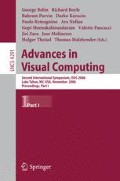Abstract
We present a novel Procedural Image Processing (PIP) method and demonstrate its applications in visualization. PIP modulates the sampling positions of a conventional image processing kernel (e.g. edge detection filter) through a procedural perturbation function. When properly designed, PIP can produce a variety of styles for edge depiction, varying on width, solidity, and pattern, etc. In addition to producing artistic stylization, in this paper we demonstrate that PIP can be employed to achieve various visualization tasks, such as contour enhancement, focus+context visualization, importance driven visualization and uncertainty visualization.
PIP produces unique effects that often either cannot be easily achieved through conventional filters or would require multiple pass filtering. PIP perturbation functions are either defined by analytical expressions or encoded in pre-generated images. We leverage the programmable fragment shader of the current graphics hardware for achieving the operations in real-time.
Access this chapter
Tax calculation will be finalised at checkout
Purchases are for personal use only
Preview
Unable to display preview. Download preview PDF.
References
Saito, T., Takahashi, T.: Comprehensible rendering of 3-D shapes. In: Proceedings of SIGGRAPH 1990, vol. 24, pp. 197–206 (1990)
Yuan, X., Chen, B.: Illustrating surfaces in volume. In: Proceedings of Joint IEEE/EG Symposium on Visualization (VisSym 2004), pp. 9–16. The Eurographics Association (2004)
Nvidia: Nv_fragment_program. NVIDIA OpenGL Extension Specifications for the CineFX Architecture (NV30) (2003)
Levoy, M.: Display of surfaces from volume data. IEEE Computer Graphics and Application 8, 29–37 (1988)
Ebert, D., Rheingans, P.: Volume illustration: Non-photorealistic rendering of volume models. In: Proceedings of IEEE Visualization 2000, pp. 195–202 (2000)
Kindlmann, G., Durkin, J.W.: Semi-automatic generation of transfer functions for direct volume rendering. In: Proceedings of IEEE 1998 Symposium on Volume Visualization, pp. 79–86 (1998)
Kniss, J., Kindlmann, G., Hansen, C.: Interactive volume rendering using multi-dimensional transfer functions and direct manipulation widgets. In: Proceedings of IEEE Visualization 2001, pp. 255–262 (2001)
Hertzmann, A.: Introduction to 3d non-photorealistic rendering:silhouettes and outlines. In: ACM SIGGRAPH 1999 Course Notes (Non-Photorealistic Rendering) (1999)
Tomasi, C., Manduchi, R.: Bilateral filtering for gray and color images. In: Proceedings of the 1998 IEEE International Conference on Computer Vision, pp. 836–846 (1998)
Ostromoukhov, V., Hersch, R.D.: Artistic screening. In: Proceedings of SIGGRAPH 1995, pp. 219–228. ACM Press, New York (1995)
Hauser, H., Mroz, L., Bischi, G.I., Gröller, M.E.: Two-level volume rendering. IEEE Transactions on Visualization and Computer Graphics 7, 242–252 (2001)
Zhou, J., Hinz, M., Tönnies, K.D.: Focal region-guided feature-based volume rendering. In: Proceedings of First International Symposium on 3D Data Processing Visualization and Transmission, pp. 87–90 (2002)
Grigoryan, G., Rheingans, P.: Probabilistic surfaces: Point based primitives to show surface uncertainty. In: Proceedings of IEEE Visualization 2002, pp. 147–154 (2002)
Johnson, C.R., Sanderson, A.R.: A next step: Visualizing errors and uncertainty. IEEE Computer Graphics and Application 23, 6–10 (2003)
Mark, W.R., Glanville, R.S., Akeley, K., Kilgard, M.J.: Cg: a system for programming graphics hardware in a C-like language. ACM Transactions on Graphics (TOG) 22, 896–907 (2003)
Van Gelder, A., Kim, K.: Direct volume rendering with shading via three-dimensional textures. In: Proceedings of the 1996 Symposium on Volume visualization, pp. 23–30 (1996)
Luft, T., Colditz, C., Deussen, O.: Image enhancement by unsharp masking the depth buffer. ACM Transactions on Graphics 25, 1206–1213 (2006)
Author information
Authors and Affiliations
Editor information
Editors and Affiliations
Rights and permissions
Copyright information
© 2006 Springer-Verlag Berlin Heidelberg
About this paper
Cite this paper
Yuan, X., Chen, B. (2006). Procedural Image Processing for Visualization. In: Bebis, G., et al. Advances in Visual Computing. ISVC 2006. Lecture Notes in Computer Science, vol 4291. Springer, Berlin, Heidelberg. https://doi.org/10.1007/11919476_6
Download citation
DOI: https://doi.org/10.1007/11919476_6
Publisher Name: Springer, Berlin, Heidelberg
Print ISBN: 978-3-540-48628-2
Online ISBN: 978-3-540-48631-2
eBook Packages: Computer ScienceComputer Science (R0)

